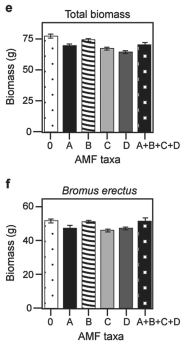Figure 31.5
Use the graphs in Figures 31.4 and 31.5 and the following information when answering the corresponding questions.
Canadian and Swiss researchers (van der Heijden et al. ,1998) ,interested in factors affecting biodiversity,grew a variety of grassland plants in combination with one of four arbuscular mycorrhizal (AMF) species,no AMF,or all four AMF species together;and they measured plant growth under each set of conditions.All plant species were grown in each plot,so they always competed with each other with the only difference being which AMF were present.Use the graphs in Figure 31.5 to answer the questions that follow.Note that the x-axis labels indicate the number and identity of AMF species (bar 0 = no fungi;bars A-D = individual AMF species;bar A+B+C+D = all AMF species together) .The y-axis indicates the amount (grams) of plant biomass for the species shown in italics above each graph.Graph (e) is the total biomass (grams) of all 11 plant species combined;graph (f) is the biomass of Bromus erectus plants only,separated from the total.


Figure 31.4 Figure 31.5
-What is the major difference between Bromus erectus (graph f) and the other plant species (graphs a-d) included in the study?
Definitions:
Mucosa
The moist, inner lining of some organs and body cavities, such as the nose, mouth, lungs, and stomach.
Lumen
The interior space or cavity of a tubular organ or structure, such as an artery or intestine, through which fluids pass.
Fenestrations
Small openings or pores, often found in the endothelial cells of capillaries, that allow for the exchange of substances between blood vessels and surrounding tissues.
Filtration Slits
Narrow gaps between the podocytes in the glomerulus of the kidney through which filtration of blood plasma occurs.
Q3: Why is it more difficult to treat
Q5: One unique feature of fertilization in flowering
Q7: Why are the renal artery and renal
Q12: If an organism was discovered that had
Q12: Islands are well known for having many
Q15: Refer to the paragraph on the research
Q20: The virus genome and viral proteins are
Q22: Why does planting a cover crop help
Q25: Glucose is transported from the intestinal lumen
Q30: The reason for differences in the sets